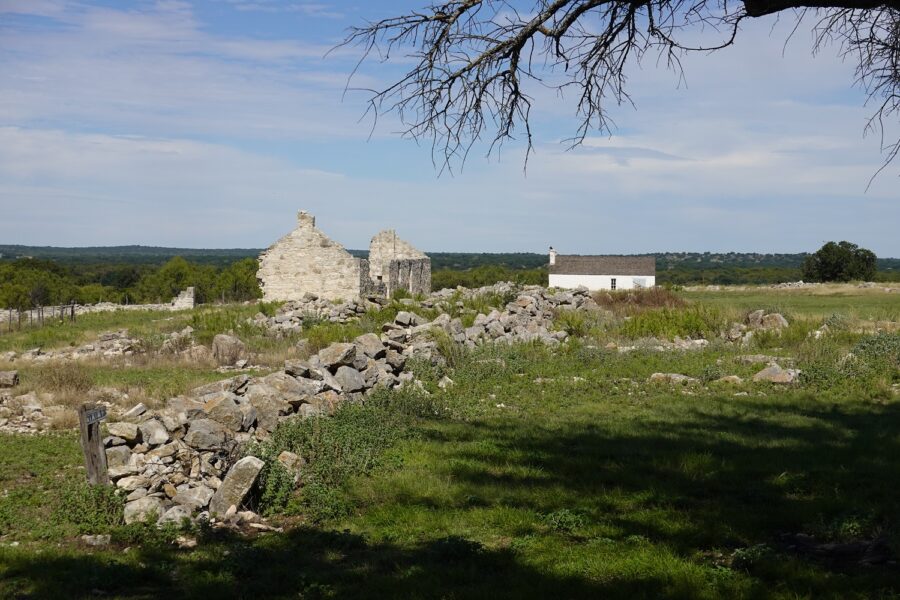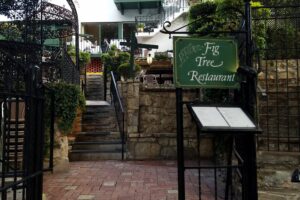Fort McKavett


I have loved Fort McKavett, ever since the first time I saw it twenty years ago. I love it even more today when I notice picnic tables nestled together under giant oaks—maybe they have always been here, and I just didn’t see. Clusters of whitewashed buildings sitting on a high hill overlooking the tree-shaded valley below always beckons, tempting me to stay – Sit for a while, Fort McKavett whispers. Let the ghosts of days gone by, the cool breeze and warming sunshine wash over you.
Unfortunately, Fort McKavett doesn’t always speak loud enough.
Standing here, talking to the friendly attendant at this historic site, I tell her, “I always wanted to be here during March to watch the reenactment of the cavalry on horseback running through the fields of bluebonnets.”
“Oh, they don’t do that anymore; they stopped about five years ago,” she replies. “Instead, they have something at Christmas.”
I mentally kick myself for procrastinating. For forgetting. For putting too many things that I want to do on the back burner of my life.
Maybe I should check out December?
The Museum
We begin our tour in the adjacent museum, and I discover information beyond the Indian Wars. I learn about Angora goat farming, with samples of sheep’s wool and Angora goat wool, aka Mohair, to touch and feel. Angora goat wins.

William L. Black
The story of William L. Black, the man who brought the Angora goat industry to Texas, is long and fascinating. Born in New Orleans to Scots-English immigrant parents, he served in the Confederate Army during the Civil War, was wounded, recuperated, and almost jailed by the Union. Black visited the Bahamas, Havana, and Panama. In service to the Confederacy as a civilian, he was convicted as a pirate, confined in Alcatraz, and spent six months in San Quentin before his mother persuaded President Andrew Johnson to commute his sentence. Black was 21 years old when he was released, and he was married approximately four years later.
Angora Goat Farming
Black was a successful entrepreneur; he became rich, always searching for another business venture. Eventually, he became a sheep farmer, purchasing 32,000 acres of land adjacent to Fort McKavett. When his ranch hands advised him that goats were preferable to sheep, he changed directions, buying eight Angora bucks and four does. The goats went forth and multiplied, and in eight years, they numbered 8,000. To thin out the herd, Black began a canning company on his ranch and sold goat meat under the label W.G. Tobin’s Chile con Carne. Becoming an expert on Angora goats, he wrote a book. He was an inventor. He was a West Texas tornado!


And I haven’t even begun to learn about the history of Fort McKavett.
Fort McKavett in a Nutshell
I discover I’m not the only one that appreciates the beauty of Fort McKavett. A famous Union General described it as “the prettiest post in Texas.”


This 150-year-old West Texas fort was part of a line of fortifications built to protect settlers from the wrath of the Native Americans, who were more than upset due to the mass invasion of other people on land that was their home for centuries.
Like other forts we have visited — Fort McKavett’s story is the same. It was like a revolving door — opening-closing-opening-closing. The fort was established, open for seven years, and abandoned because the war with Native Americans declined due to the establishment of reservations. After the Civil War, the Comanches became restless, weary of too many settlers invading their space. So Fort McKavett reopened nine years after closing and remained open for the next fifteen years. The military abandoned the fort in 1883.
When the Army left, settlers began moving into the empty buildings, and the town of Fort McKavett was born, lasting 100 years before the last residents moved out of the original fort’s buildings. Five years before that, Fort McKavett became a state historic site.
A Soldier’s Life
If I read one more word or learn one more thing, I will need a nap. But I can’t help myself.


I notice a storyboard that asks me hypothetically — what I would spend my monthly paycheck on as a private in the Army after paying for my laundry and a few other necessities not provided by the military. The price of various small luxuries is listed, and it is a hard choice. The princely sum of $13 is my monthly stipend which barely equals $420 in 2021. However, my housing, food, and medical expenses are taken care of.
Along with items available for purchase at the post trader store, a town across the river called Scabtown was filled with human parasites who were too ready to relieve a soldier of his pay. Scabtown was a collection of ramshackle buildings—many of them lean-tos—selling wares and services (aka vices) not allowed to be sold on the post.
I learn about soldiers growing vegetables on good land just beyond the post close to the San Saba River. The Army urged the planting of gardens to help provide fresh fruits and vegetables, giving the soldiers necessary vitamins and minerals not found in regular rations. The gardens also probably offered the soldier a little bit of joy in working the land and seeing their toil come to beautiful fruition.
The Prettiest Post in Texas
I’m ready to explore the old fort and not read another thing — we’re going to run out of daylight if I don’t stop.
We leave the museum, aka former military hospital, and step onto the grounds of Fort McKavett, considered one of the best-preserved and most intact examples of a Texas Native American Wars (1850–1875) military post.
Making our way to the buildings edging the extensive parade grounds, we are alone — as alone as alone can get on this windswept Sunday afternoon. I become involved in taking a picture of an old knurled oak and lose Michael to his wanderings. It seems I always lose Michael, but I know he will show up eventually.


In addition to the beautifully restored whitewashed buildings consisting of headquarters, officers’ quarters, barracks, hospital, schoolhouse (for soldiers), sink (privy—one for officers, one for enlisted men), and the dead house (in back of the hospital), there are piles of ruins. They are torn and crumbled antique art. I could pretend I am in England and say the scope of this fort is massive, even though — based on the model in the museum — over half of the buildings are completely gone. Vanished. What is left is neat and orderly and pristine and clean—and slightly scarred.






Walking Into History
I am a voyeur of past lives, walking into history, given a tiny taste of what was. Clothing hung neatly on hooks in the barracks—straw mattresses, neatly rolled, unappealing slatted cots exposed. In the officer’s quarters, there is a meal half-finished. A bed. Night clothes. Desk. Table. A chair. Washstand. A fireplace. Each one is different. We explore every nook and cranny available for us to peek into.



Our wanderings take us to the bakery that is well away from other buildings. I am fascinated that the floor is thoughtfully laid with stone; Michael is fascinated with the buzzards making themselves comfortable on the roof.


Our bones are weary, and our feet are tired — it has been a long day. We sit on a porch bench of one of the officer’s quarters and watch the wind play with the flag. Then stop — and start again. The breeze is fickle this perfect day.


Late in the afternoon, we make our way to the car. Michael asks me if there is a backway into Brady. I look, this is definitely not the Hill Country where all roads are paved, leading to another that eventually leads to a familiar ranch road or farm road. The tiny lines on the map I look at leads me south, almost to Fort Mason. The squiggles that lead north are gravel and long.
We retrace the route we took this morning and drive to our temporary home in the Hollywood Texas Suite in the Trucountry Inn — and dinner.
Fort McKavett
- Address
- 7066 FM 864, Fort McKavett, TX 76841
- Phone
- (325) 396-2358
- Hours
- Daily 8 a.m. to 5 p.m.
- Closed Thanksgiving Day, Christmas Eve, Christmas Day, Day after Christmas, New Year’s Eve, and New Year’s Day.
- Admission Fees
- Adults: $4
- Seniors: $3
- 5 and under: Free
- Ages 6-18, College Students, Adult Tour Groups: $3 Per Person
- Family Fee: (2 Adults/1 Child or 1 Adult/2 Children) $8
- Each additional child: $1
- School Groups: (Reservations Required): $1









Leave a Reply
Your email is safe with us.